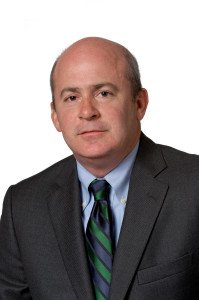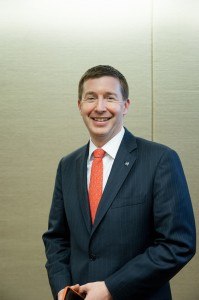

Q: The Pricing Environment.Recent rating agency reports contained the following observations about the reinsurance pricing environment:
S&P: “Price competition for global property/casualty reinsurers has been fierce for the past few years, and Standard & Poor’s Ratings Services sees no signs of the trend reversing course in the near future.”
Fitch: “There are some recent signs that the market is stabilizing…The reinsurance market showed signs of decelerating rate declines in its most recent June/July 2015 renewals, indicating that pricing could be approaching a new equilibrium.”
Which view do you believe is right? What is your view of pricing trends for the property reinsurance and casualty reinsurance segments?
 Brian Boornazian, Chairman, Aspen Re and President, Aspen Re America
Brian Boornazian, Chairman, Aspen Re and President, Aspen Re America
We are certainly seeing some stabilizing of pricing in most lines. That said, we are by no means seeing any firming, rather more of a bumping along at the bottom of the market. Unfortunately, barring any major event, I see this bumping along at the bottom continuing for the foreseeable future. If you look at loss costs, there really isn’t room for more softening. I think the market has matured over the years and the sophistication of underwriting has evolved such that the understanding is pretty clear among quality companies that writing business below current rate levels will likely set you on a path of no return.
 Tad Montross, Chair and CEO, General Re Corp.
Tad Montross, Chair and CEO, General Re Corp.
Prior-year positive reserve runoff, a benign cat period, favorable loss trends and alternative capital have put pressure on reinsurance rates globally.
While overall prior-year runoff has been positive, we are beginning to see adverse development in the more recent accident years. The 2013 global insured cat losses were 28 percent below the 10-year average, followed by 38 percent below in 2014 and 45 percent below for the first six months of 2015. We haven’t had a hurricane make landfall in Florida for nine years. The last time we had such a good string of luck was in 1851.
Frequency trends, which have been negative for many lines, seem to be reverting to the mean. And we are seeing an uptick in severity for commercial auto and property.
And in a world awash in liquidity, the capital markets are showing a keen interest in reinsurance and insurance-linked securities. Investors are chasing yield.
If we look at exposure instead of experience—a more robust economy; a warmer, wetter world with sea levels on the rise—we are likely to see a stabilization and even rate increases in many lines of business.
 Chris Donelan, President and Chief Underwriting Officer, Endurance Re U.S.
Chris Donelan, President and Chief Underwriting Officer, Endurance Re U.S.
It’s difficult to make a blanket prediction as we are seeing different trends depending on the line of business. In liability lines, I don’t really anticipate much further deterioration in terms unless we continue to see sustained positive trends in the underlying profitability drivers such as loss cost, interest rates, inflation, etc. We are very focused on understanding these leading and lagging indicators as they will be key to our future underwriting decisions.
On the shorter-tail lines, price will fluctuate based on overall supply and demand, although reduced demand and consolidated cedent panels resulting from the recent M&A activity may possibly dampen some of the price sensitivity.
For both of these classes, future pricing trends will be very dependent on developments in the loss environment, but I’m confident that, as a whole, the underwriting environment is better equipped than ever to handle this challenge.

Gregory S. Hendrick, Executive Vice President and Chief Executive, Reinsurance Operations, XL Catlin
In the property-catastrophe market we are seeing a floor start to emerge, much like in 1999 and 2000, driven by a realization that rates are no longer commensurate with the risk in some short-tail lines. While the market may not have hit the bottom quite yet, rate declines have slowed, the ILS market pricing is stable, and we have seen some deals repriced over the last few months.

Bill Donnell, President of U.S. Property/Casualty, Swiss Re
It’s true that in recent years the market has been highly competitive. There’s been ample capacity in the market, and many companies have been trying to maintain relevance. We’ve noticed a “stall” in price changes in the middle of the year when the Florida market is historically most active. Is this a new equilibrium? What does the future hold? It depends on many factors that are constantly in flux.
The returns that brought much of the alternative capital into the market are much lower now. Interest rates are expected to rise, but the timing of the move and the magnitude is unknown.
With regards to our own portfolio, our goal is to differentiate Swiss Re, working with clients on collaborative solutions. This changes the dialogue from price to the value of partnerships and how we can be smarter together.
(Editor’s Note: Donnell is set to leave Swiss Re on Dec. 7 to become president and CEO of the National Council on Compensation Insurance.)
 Steve Levy, President, Reinsurance Division, Munich Reinsurance America Inc.
Steve Levy, President, Reinsurance Division, Munich Reinsurance America Inc.
While price competition has been fierce for the past few years and prices continue to soften, the pace of softening slowed in the recent renewals.
However, it is difficult to predict the outcome of the renewal negotiations. We expect the general environment to be mainly unchanged. Competition should remain intense as long as there are no extraordinary loss events or other major market upheavals during the last months of the year, but the pressure on prices should ease still further after two years of price deterioration.

Mike Krefta, Chief Underwriting Officer, Hiscox Re
As a market we have reached the floor, although there will always be some variations in geographies and different lines. On the casualty side, we tend to write business from the smaller casualty insurers where there is more stability in pricing, which I would say is mirrored now on the property side.
 Michael Sapnar, CEO, TransRe
Michael Sapnar, CEO, TransRe
Stabilizing is a good word. I don’t know if we’ve hit bottom, but it’s stabilizing.
According to the cat-pricing index published by Guy Carpenter, we’re still at levels that are twice where pricing was in 1990, accounting for trend and attachment point. It’s still possible to build a good quality, diversified property-cat portfolio with reasonable risk return tradeoffs. Clearly though, the fat or the margins that were in property-cat historically, that helped offset maybe difficult pricing in other lines of business, aren’t there. So property-cat isn’t going to mask results elsewhere.
I do think the slippage is abating in property-cat pricing. I don’t know whether there’s ever a floor. Casualty reinsurance rates have also abated a bit.
Terms and conditions are probably more worrisome right now. Those have been expanding, as have commission expenses, which have certainly been trending up.
However, the issue is that reinsurance is a derivative—and it’s a derivative and a function of the upfront insurance underwriting, pricing, and terms and conditions. We have not seen the deterioration on the insurance side that we have on the reinsurance side yet, and I think that will come. So to the extent that the insurance marketplace becomes more competitive, that will affect reinsurance. As a derivative, we will have collateral damage.